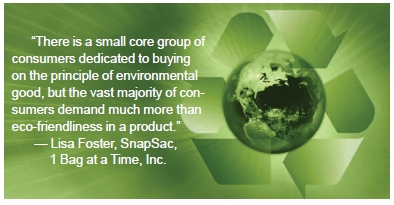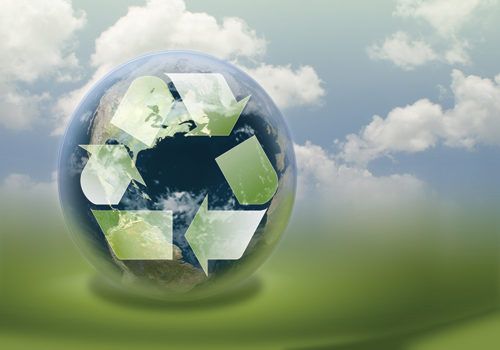Strip away the associations with “greenness” and Earth Day, and the word “environment” should mean something equivalent to “surroundings.” Nobody wants their surroundings to be poor or unhealthy, but some consumers are more conscious of this need than others, manifesting that awareness in their choices of home care and other types of products. Here is a look at the selections they make, and why they might make them.
Perspectives on Green
Every eco-friendly product has a story to tell. The ins and outs of environmental impact can cover a lot of ground, from the production plant to the home to the landfill. One product might reduce the amount of harmful chemicals that make it into the soil after the product is disposed of, while another might make a consumer’s day easier while improving the air quality in his/her home.
Along with product quality and effectiveness, which for eco-friendly cleaning products has been a concern in the past, it is about lifestyle principles for eco-friendly companies like J.R. Watkins, Winona, MN. President and chief marketing officer J.R. Rigley says the use of environmentally friendly ingredients to help people feel better, live healthier and have a clear conscience is their focus. “We’re very conscious of the ingredients we use in our products. Our products are made from renewable, plentiful ingredients from nature,” says Rigley.
This translates into some concrete assurances to consumers. “We have a Freedom Code as it relates to our personal and home care lines, in which we transparently state the ingredients you’ll never find in our products,” he says, and lists ammonia, animal ingredients, benzene, bleach and 16 others, all the way through to sulfuric acid, among those avoided ingredients.
The reasons for omitting certain ingredients include both personal wellbeing and environmental protection. A key measure of a product’s “greenness” in this regard is the primary or exclusive use of plant-based ingredients, according to Van Vlahakis, CEO and founder of Earth Friendly Products, Winnetka, IL. He says his company is actually involved in a process that can determine, through the use of carbon dating, whether an ingredient is truly plant based.
In addition, Mona Weiss, co-founder and owner of Eco Nuts, Marina Del Rey,  CA, explains naturalness, or lack of chemicals in an end product is not the end of the story. Harmful chemicals may still be used in the growth or production process, and she believes this is one reason why some products carry an eco-friendly certification or two to show the consumer that a product is green through and through.
CA, explains naturalness, or lack of chemicals in an end product is not the end of the story. Harmful chemicals may still be used in the growth or production process, and she believes this is one reason why some products carry an eco-friendly certification or two to show the consumer that a product is green through and through.
It’s not just a matter of excluding potentially harmful ingredients, Weiss says, but of choosing alternative ingredients that are both safer and able to do the same job within the context of the product. “As far as the cleaning industry goes, there’s no shortage of cheap chemicals. It’s far more of a challenge to source sustainable materials that are safe for people and the environment than it is to find harmful chemicals that are affordable,” she says.
Moving beyond the realm of ingredients, Vlahakis explains how manufacturing and logistics factor into the eco-friendly equation. “We have five manufacturing facilities, running with the latest in green energy and technology, strategically placed across the United States to keep our carbon footprint low. Being the primary manufacturer and shipping and sourcing locally is another way we keep our costs low while also stimulating and supporting the economy,” he says, adding that these savings are passed on to consumers. The takeaway is that green doesn’t have to mean more expensive or inefficiently produced.
The production of the raw laundry soap offered by Weiss’s company has an ecological footprint, by virtue of the fact that its ingredient, a Himalayan berry that naturally produces soap, grows on a tree. She says the company offsets its production by using packaging with soy ink, Forest Stewardship Council (FSC) certified paper and wind power. Weiss has seen companies use creative solutions for packaging that go beyond traditional recycled materials, including molded pulp, tapioca and mushroom roots. These solutions may become more cost effective in the future, but for now, petroleum-based plastic is the norm, she says. Smaller companies with less buying power, especially, may have harder times coming out with eco-friendly packaging.
The eco-friendliness of not just the product itself, but its container and how it’s disposed of, has been a focus for Weiss and her company. She says their cardboard and aluminum packaging for holding liquids can both be recycled at any recycling center. While the eco-friendliness of the materials can make a difference, cutting down on waste provides even more value. Aluminum had limited the size of their containers in the past, Weiss says, so her company’s new solution is a BPA-free “wine box” lined with recyclable plastic that can hold over three liters of concentrated detergent, good for over 600 loads of laundry and replaces 19 plastic detergent bottles.
In some cases, this waste reduction is the whole point of the product. Bambooee is a reusable paper towel product made from, what else—bamboo. “We ensure that the bamboo that is used for our product is grown and harvested in a sustainable way,” says Irene Spiegel, operations at CM National Inc., makers of Bambooee. The product comes in a perforated roll and fits in a standard paper towel dispenser. The value of products such as this becomes clear through the statistics. “Each sheet of Bambooee can be washed up to 100 times. Thus, one roll of Bambooee replaces up to 286 paper towel rolls. In some households, that is 5.5 years of paper towel use,” says Spiegel.
Using this material in place of recycled paper towels may reduce BPA exposure, she notes. Then, there are the rainforests to protect. “Only 7% of the Brazil rainforest still remains. According to the World Resource Institute based in Washington, D.C., the rate of rainforest destruction is 214,000 acres of trees cut down a day. In the United States we spend $2.5 billion on paper towels a year. Three thousand tons of paper towel waste is produced a day,” says Spiegel. There is also the amount of water and other resources used to produce paper to consider. A compostable version of these bamboo-based towels is in the works, according to Spiegel.
There are personal benefits and savings to be had for consumers that integrate these products into their lives. “If someone is suffering from allergies or skin problems, sometimes what they thought was an allergy was just a sensitivity to a product or chemical. So, switching to a product that doesn’t contain any of those chemicals that irritate their skin may resolve issues for the person,” says Weiss.
She adds that her company’s product is USDA certified organic, but costs only a third of what some regular detergents do, thus combining value pricing with organic quality. The replacement of 5.5 years of paper towel purchases is likewise of obvious value. Eco-friendly products can also reduce hassle and simplify daily life. “Buying paper towels, running out, buying them again, and running out again is no longer necessary,” says Spiegel.
These trips back and forth to the store are the scene of another eco-friendly revolution taking place. The momentum for reusable bags has grown in recent years. “We have focused so much on recycling since the 70s, but many people just use ‘it’s recyclable’ as an excuse to over-consume,” says Lisa Foster, founder of SnapSac, made by 1 Bag at a Time, Inc., adding that her company’s reusable shopping and tote bags embody the even more eco-friendly principle of “reuse.” She believes that consumers can help themselves by trading up and committing to something that lasts like a reusable bag, and just as importantly, making it a habit. “An item that is durable can be used for years without affecting resources. My philosophy is: have better stuff, not just more stuff,” she states.
Eco-Friendly? Who Cares?
Really, who cares? What types of people do eco-friendly product makers find are most often interested in their products? “There is a small core group of consumers dedicated to buying on the principle of environmental good, but the vast majority of consumers demand much more than eco-friendliness in a product,” explains Foster. Her firm’s consumer research shows that 54% of consumers use reusable bags on a regular basis today, but those same people rate themselves a seven out of 10 on average when it comes to concern with the environment.
She explains this slight disconnect by pointing to the usefulness and versatility of some reusable bags. They have appeal beyond doing good for the environment, such as increased comfort, decreased clutter and more carrying power than a thin grocery bag. That a majority of consumers say they sometimes use reusable bags is an “awesome number,” Foster says, considering that in 2005 only 5% said they used them. “I spend a lot of time thinking about how can we get the next 25% on board? What would it take to entice them into the reusable habit?” she wonders. She does know that studies have shown reusable bags to be a keystone habit, leading people to make many other changes that reduce waste.
 For those that buy them, Spiegel says that products like bamboo-based reusable towels have an obvious appeal, and that is waste reduction. Weiss, meanwhile, sees interest in eco-friendly soaps coming from younger customers and moms. She believes those that “get it” see that their purchases impact the planet as well as their own health. “People are starting to make the connection that a healthy environment means healthy people,” says Weiss.
For those that buy them, Spiegel says that products like bamboo-based reusable towels have an obvious appeal, and that is waste reduction. Weiss, meanwhile, sees interest in eco-friendly soaps coming from younger customers and moms. She believes those that “get it” see that their purchases impact the planet as well as their own health. “People are starting to make the connection that a healthy environment means healthy people,” says Weiss.
Rigley echoes Weiss, saying, “We have found that a wide range of customers are seeking eco-friendly products—particularly women looking for products they can feel good about using for themselves, their families and their homes.” These individuals don’t want to compromise on product quality and efficacy, or on personal/ethical standards.
“Our consumer base ranges greatly from environmentally conscious consumers to parents that simply want a safe, effective product that is value priced,” says Vlahakis. Weiss concurs, saying that new parents and pregnant women are particularly open to change, because they want their baby to experience a healthy world. Concerns about the links between ADD and pesticides, autism and chemical exposure, etc., are also drivers of interest in eco-friendly home products, according to Weiss.
Most people won’t completely change certain choices or habits, she goes on to say. But they may, for instance, choose a cloth diaper for their child instead of disposable ones, or switch brands of laundry detergent. The cost factor is a big one, Weiss adds, in that if consumers find a new eco-friendly version of a product that costs the same or less, does the same job and is better for the environment, the resistance to purchase is dramatically lowered.
According to Vlahakis, talking up the attributes of individual products can help with acceptance. Citing his company’s products as an example, he says qualities such as being manufactured in the USA, paired with being cost effective and safe for family, pets and the environment have helped make their laundry detergent successful. Weiss also thinks that employee recommendations can go a long way in helping consumers make decisions about switching to eco-friendly products. She says retailers should also consider in-store raffles and other events to educate customers on more environmentally-safe product choices.
For their own part, eco-conscious consumers have tools at their disposal to help them sift through all the green marketing language. One is Veritey, a Web-based resource aimed at making eco-living easier, by helping consumers identify and purchase products that meet certain standards. The eco-friendly and non-toxic products reviewed on the site include everything from baby gear to furniture and jewelry. “Every product featured on Veritey has been vetted and tested for use. Our eco/sustainable seal is bestowed upon products that are truly sustainable and are best in class,” says Amy Ziff, founder of Veritey.
The lack of regulation of sustainable, natural, eco and other labels leaves consumers with “a difficult time differentiating between green and green-washed,” says Ziff. Tools like this one, along with other eco-commerce portals on the Web, allow consumers to come into close contact with responsible brands. WF
Published in WholeFoods Magazine, April 2013









